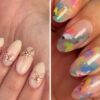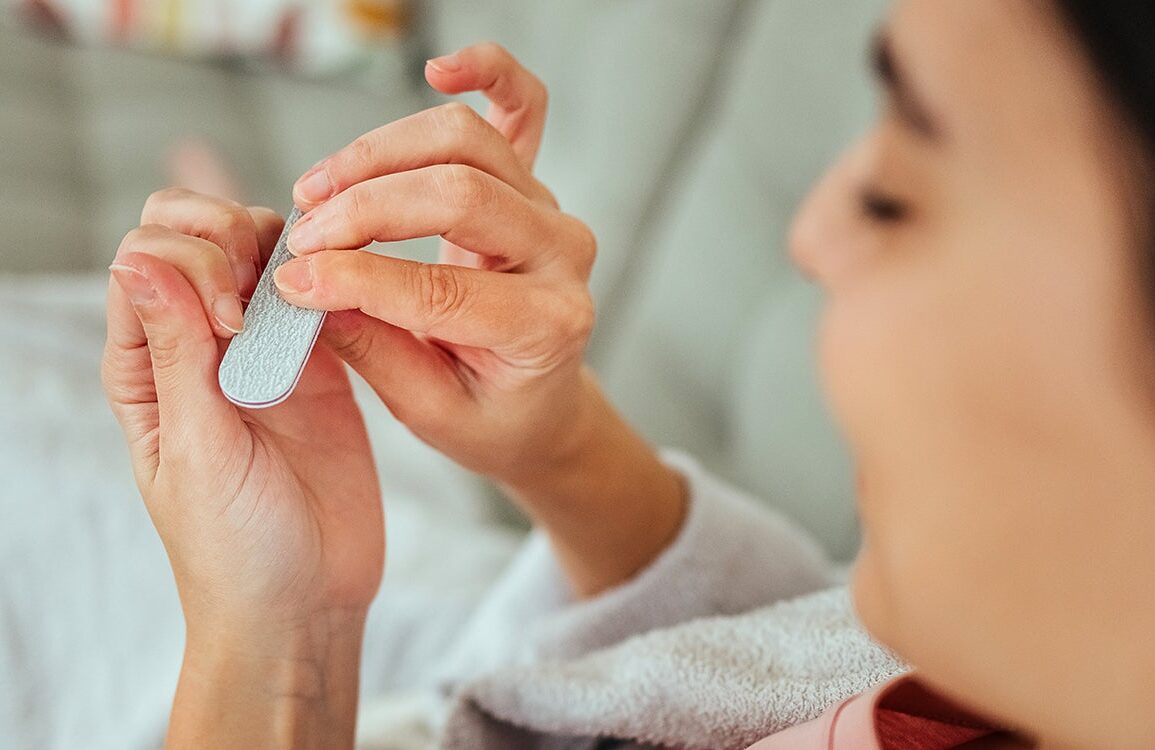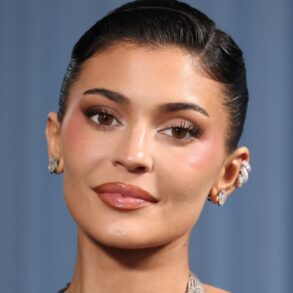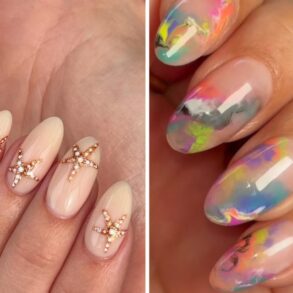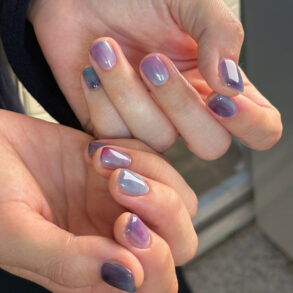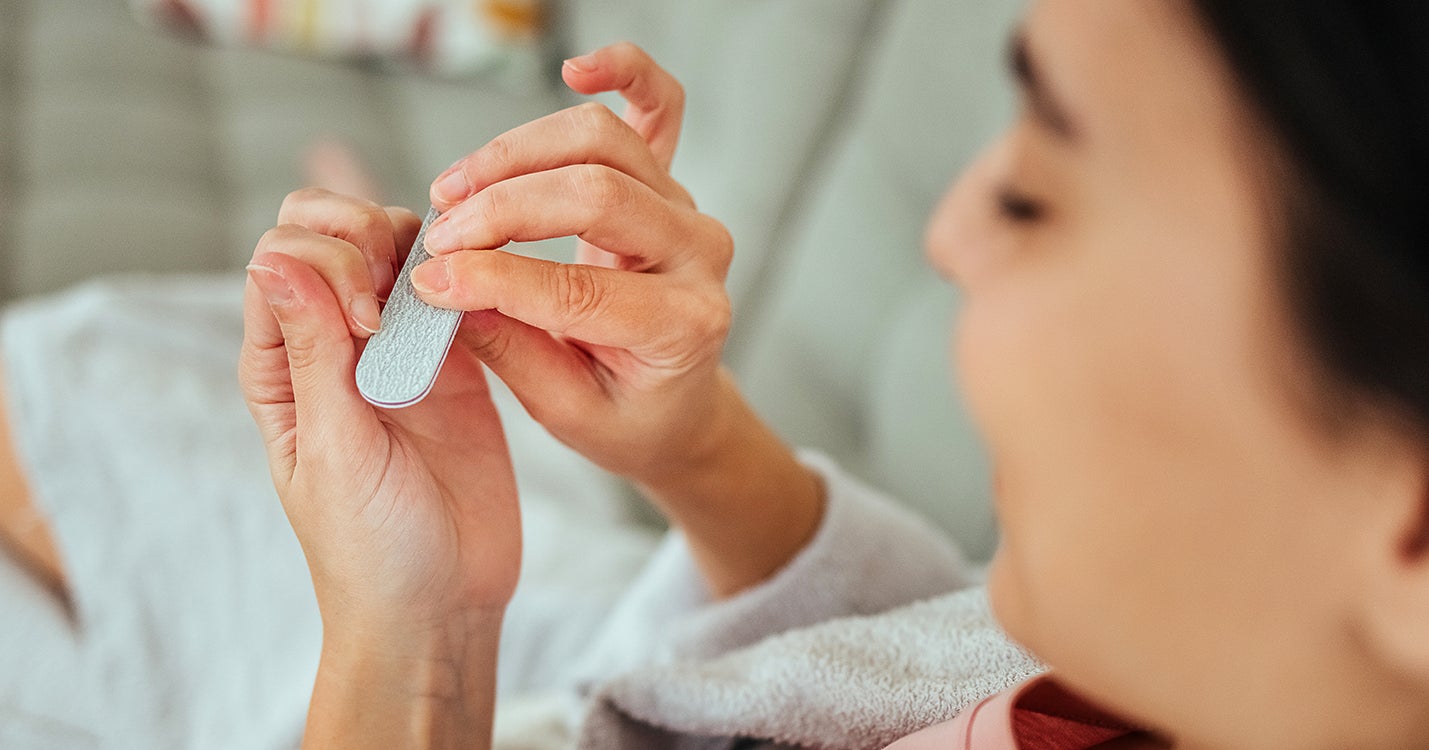
“My hairline is so weird.”
“My pores are huge.”
“My nail beds suck!”
Like most millennials, countless Mean Girls quotes are indelibly burned into my brain, but this last gripe is the one still smouldering. That’s because every time I go to my local beauty salon, I leave with a similar feeling of disdain towards my nails — usually a result of the following comments:
“Not much I can do with these.”
“Why don’t you do extensions?”
“So small!”
You see, I’m one of many people with genetically short nail beds. In the grand scheme of things to worry about, the length of the area between your cuticle and tip of your nail isn’t a big one, I know. But now more than ever, nails — in particular how aesthetically pleasing they are — seem to be at the forefront of discussion. It makes sense: With costs rising left and right, manicures are an uplifting and affordable luxury for many. The experience can be a little different for those of us with short nail beds, though.
The recent online conversation around short nail beds can be traced back to the comments section of a viral TikTok video captioned, “You might think that no one notices your nails, but I actually think it plays a big role in pretty privilege.” In the clip, which has amassed 1.4 million views, the poster @egybestie feels that she is taken more seriously when her nails are done, and calls the manicure a “door opener”. The post sparked a heated discussion about beauty standards, namely the pressure placed on women to look “groomed” at all times. Among the hundreds of comments, one stood out: “I thought you were gonna talk about the pretty privilege of your actual nail beds,” wrote a viewer. “Some of ya’ll have the perfect nail beds and mine are out here all wonky and wide.” Interestingly, it’s one of a few comments that received a reply from the poster: “I REALLY SHOULD’VE,” @egybestie responded. “I have naturally short [nail]beds so I [definitely] feel like long nail beds are pretty privilege.”
@egybestie You might think that no one notices your nails but I actually think it plays a big role in pretty privilege #prettyprivilege ♬ original sound – egybestie
Pretty privilege suggests that those who are typically attractive by Western standards (think straight hair and white skin) have better advantages. If social media is anything to go by, long nail beds are included in this list of desirable attributes. But where did such a beauty bias come from, and where does it leave those who don’t — mind the pun — measure up?
What is the history of favouring long nail beds?
Long nails, and by association the appeal of long nail beds, spans centuries. Well-to-do women in the Chinese Ming and Qing dynasties wore lengthy and elaborate nail covers (made from precious metals and stones) to protect their long, natural nails, which were emblematic of social status and wealth. Centuries later, Queen Elizabeth I of England was known for her obsession with her long, slender fingers and nails, reports historian Dr Amy Boyington; these were emphasised — and often exaggerated — in her portraits and other depictions throughout her reign. Most famous is the Armada portrait of 1588 in which Queen Elizabeth’s long fingers are draped over a globe: the ultimate symbol of female power following the Spanish Armada’s defeat by the English army.
With an estimated 23,000 nail salons in the UK alone, the modern equivalent of this power pose would likely be a nail selfie. Whether you opt for gels, acrylics or regular polish, it has become second nature to post our nails online, but a quick scroll through the hundreds of millions of Pinterest and Instagram photos proves that manicures on long nail beds are by far the most popular.
Why are long nail beds deemed more beautiful?
Luxury manicurist and content creator Lois Elias notices much higher engagement on content where nail beds are long, not short: “I think people enjoy ‘aspirational’ content, even if it’s unattainable for them personally,” Elias tells Refinery29. Similarly, Refinery29 Unbothered editor L’Oréal Blackett is often the talk of her local nail salon thanks to her long nail beds. “The first time I realised my long nail beds were desirable was when a school friend tried to prise my nail from my finger,” says Blackett. “She didn’t believe they were mine.” She adds, “Manicurists often comment on them when my nails are being filed and shaped. I’m usually told that I’m ‘lucky’ or that my nails are ‘elegant,’ which leads to other clients looking over to compliment them, too.”
The word “elegant” seems to be synonymous with long nail beds. Interestingly, session manicurist Ami Streets says that long nail beds are not only perceived as a “symbol of elegance” but also “femininity”. Streets, who does nails for magazine shoots, adverts and campaigns, adds that features associated with more classically “feminine” attributes, such as longer nail beds, smaller hands and longer fingers, tend to be used for aspirational (and often expensive) jewellery, beauty and fragrance content.
Conversely, people often give short nail beds masculine connotations, says Elias. Short nails, nail beds and coarsened hands have long been associated with “masculine” work such as manual labour — also linked with lower classes. Perhaps it isn’t a coincidence that the trending TikTok hashtag #oldmoneymanicure (essentially the nude nail aesthetic of upper-class women) serves up photos of long nail beds studded with gems and pearls. Not only are long nail beds widely considered markers of class and status, they are inexplicably tied to gender identity, namely looking “womanly”.
Are long nail beds yet another beauty standard?
Fashion and beauty psychologist Shakaila Forbes-Bell says that beauty standards such as favouring long nail beds are rooted in evolution: “Over the years, certain traits have been deemed more ‘attractive’ for certain gazes,” says Forbes-Bell. From the perspective of the male gaze (a power dynamic where women are objectified by men), women are expected to be adorned and “pretty.” When it comes to long nail beds in particular, there’s more room to decorate, says Forbes-Bell, whether with nail colour or intricate nail art. Sadly, this maintains the impractical, antiquated and ultimately sexist ideal that women should be well groomed or dressed up at all times. Celebrities certainly aren’t excused: Love Island’s Megan Barton Hanson and actress Megan Fox have both been on the receiving end of unsavoury comments about their short thumb nails, with TikTokers and even online publications referring to them as “toe thumbs.”
From a practical point of view, certain nail art (think tortoiseshell print and aura nails) requires the larger canvas of a long nail bed, says Streets. This is something George Driver, communications director at Karla Otto and former senior beauty editor at ELLE.co.uk, knows all too well: “Literally no nail places will do nail art for me because my nails are so small,” she says. “The most they’re ever happy to do (read: not genuinely annoyed with me about) is a novelty dot.” Driver continues, “I stalk [nail artist] Betina Goldstein-esque images and it took me so long to realise I couldn’t get the same look; not because my nails weren’t long enough on the ends but because my actual nail beds weren’t long and piano-like.” For Driver, long nail beds are up there with wedding dress models: “You take the vision with a massive pinch of salt.”
Not only is our obsession with long nail beds exclusionary, it’s also problematic. In the era of body neutrality, words like “slim” and “slender” feel outdated. Yet in the context of nails, and favouring long nail beds, they are used frequently. Take the trending “Italian” manicure, for example, which leaves the edge of the nail free of polish to create the illusion of more elongated, “slimmer” talons. In a similar vein, Streets says that longer nails, and by association long nail beds, are generally seen as more aspirational because they are thought to be a sign of “good health”, much like glowing skin and long hair. On the other hand, very short nail beds are synonymous with nail biting, a habit that makes us vulnerable to dirt, bacteria and illness.
What determines the shape of our nail beds?
In reality, genetics mostly determine the shape and length of our nail beds. Happily, nail enthusiasts are not afraid to point out the bias. In the #redditLacqueristas Reddit thread, a space for like-minded nail devotees, one poster amassed 120 passionate comments when they recently asked, “Does everybody here have beautiful hands?! Literally all of you have the most perfect hands, long, slender fingers with nail beds the length of airport runways.” One reply earned the most upvotes: “People with the ‘ideal nail’ will be more likely to show their nails off because they can expect positive reactions,” wrote one poster. If a trait is continually presented as “attractive” to us, and receives validation through likes and comments, we will eventually internalise it as a beauty standard, says Forbes-Bell. “Your psychology tells you that anything which doesn’t fit the status quo is often deemed negative,” she adds.
Not all long nails are considered a societal beauty standard, however. Many Black women face judgement and discrimination for their long nails and intricate nail art. Aesthetician and beauty writer Alicia Lartey previously told R29 that she is treated differently based on the length and colour of her nails. “If I go for simple, short designs, I find that [beauty] brands are nicer to me and people treat me with more respect,” Lartey said. “If my nails are long and elaborate, it’s always a very negative experience,” she added.
Like many other beauty standards, Streets believes that the infatuation with long nails beds is highly unrealistic: “Not everyone necessarily has the income — or the genetics — to reach these ever-evolving beauty ideals,” she says. Two beauty editors challenging the algorithm are Laura Capon and Lucy Partington, who set up the Instagram account All Nails Welcome after becoming frustrated with the lack of diversity in the nail industry, particularly with the rise of “luxury” manicurists. “Their feeds were filled with nothing but hand models, who had nail beds longer than our to-do list,” Capon tells R29. “As a (now reformed) nail biter with chubby hands, I knew how it felt to have your artist skip the usually mandatory ‘after’ photo. Not only is it elitist, but it’s not helpful when looking for inspiration. We want to see how a design translates to shorter, wider nail beds as well.”
Manicurists need to do better to ensure they are not only representing their paying clients better, adds Capon, but also their own work. “A sheer nude on hands worth of insurance doesn’t cut that,” she says. Forbes-Bell also suggests curating your social media feed. Instagram’s Favourite and Following features, for example, give you more control over what you see.
As Elias puts it: “I think the pressure to conform to ideals distracts from the fun and joy of nails.” Like bodies, nails come in all shapes and sizes. To elevate or to place more value on one over another is inane. Whether you never miss a gel appointment or do nothing to your nails at all, let’s collectively embrace the diversity of how they can look.
This post was originally published on this site be sure to check out more of their content.


